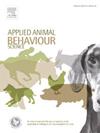选择对马的行为,心率和心率变异性在人-马触摸互动的影响
IF 2
2区 农林科学
Q1 AGRICULTURE, DAIRY & ANIMAL SCIENCE
引用次数: 0
摘要
人与马之间的触觉互动是几乎所有马辅助服务(EAS)的共同特征,尽管人们对马在人与马的互动中如何感知这种触觉刺激知之甚少。目前的研究评估了三种类型的触摸(拍,抚摸,抓挠)对治疗马的三个解剖身体部位(颈部/肩部,身体,后躯)的影响(N = 10)在强迫和自由选择触摸治疗下对马的行为,心率(HR)和心率变异性(HRV)。人类参与者(25人对马有经验,24人对马没有经验)在一个熟悉的圆形围栏中,在两种治疗条件下分别与四匹马进行互动。在强制触摸治疗期间,在测试期间(4.5 min)拴住马,并指示参与者用每种类型的触摸触摸每个身体位置,每30 秒切换一次。在自由选择触摸治疗中,马在围栏中是松散的,参与者站在中间,被指示只有当马在手臂可以触及的范围内才能触摸马。一个具有重复测量的广义线性混合模型检验了治疗、触摸类型、位置和人类与马的经验对马行为、HR和HRV的影响。口腔行为、烦躁不安和摇尾更频繁,而在强迫触摸治疗中,摇头行为比自由选择触摸治疗更少(均p <; .0206)。与触摸脖子/肩膀和身体相比,触摸后躯时,尾巴摆动的频率更低(p <; .0001)。与强迫触摸治疗相比,自由选择触摸治疗导致高(OR = 0.10, 95 % CI(0.05, 0.20))和均匀(OR = 0.04, 95 % CI(0.03, 0.06))头位的几率较低,低(OR = 9.75, 95 % CI(7.84, 12.12))头位的几率较高。与强迫触摸治疗相比,在自由选择触摸治疗期间,马不太可能将耳朵朝向参与者(OR = 0.19, 95 %(0.15,0.23))。与强迫触摸治疗相比,自由选择触摸治疗的马HR更高(p = .0007)。马HRV在与经验丰富的参与者互动时低于经验不足的参与者(p = .0293)。结果表明,治疗马对强迫触摸治疗没有积极的感知,这突出了在EAS期间为治疗马提供选择和代理的重要性。研究结果可以反映在治疗马组织的指导方针中,以尽量减少人类受伤的风险,确保马的良好生活。本文章由计算机程序翻译,如有差异,请以英文原文为准。
The effect of choice on horse behaviour, heart rate and heart rate variability during human-horse touch interactions
Touch interaction between humans and horses is a feature common to almost all equine-assisted services (EAS) although less is known about how horses perceive this tactile stimulation during human-horse interactions. The current study assessed the effect of three types of touching (patting, stroking, scratching) on three anatomical body locations (neck/shoulder, body, hindquarter) of therapy horses (N = 10) on horse behaviour, heart rate (HR) and heart rate variability (HRV) under forced and free-choice touch treatments. Human participants (25 experienced and 24 less experienced with horses) each interacted individually with four horses in both treatment conditions while in a familiar round pen. During the forced touch treatment, the horse was tethered for the duration of the test (4.5 min) and the participant was instructed to touch each body location with each type of touch, switching every 30 s. During the free-choice touch treatment, the horse was loose in the pen and the participant, standing in the centre, was instructed to touch the horse only if the horse came within arm’s reach. A Generalized Linear Mixed Model with repeated measures examined the effect of treatments, touch type, location and human experience with horses on horse behaviours, HR and HRV. Oral behaviours, restlessness and tail swishing were more frequent, while head shaking behaviour was less frequent during forced than free-choice touch treatments (all p < .0206). Tail swishing was less frequent when touching the hindquarters in comparison to touching the neck/shoulder and body (p < .0001). Free-choice touch treatments resulted in lower odds of high (OR = 0.10, 95 % CI (0.05, 0.20)) and even (OR = 0.04, 95 % CI (0.03, 0.06)) head positions and higher odds of low head positions (OR = 9.75, 95 % CI (7.84, 12.12)) compared to forced touch treatments. Horses were less likely to keep their ears oriented toward the participant during free-choice touch than forced touch treatments (OR = 0.19, 95 % (0.15, 0.23)). Horse HR was higher during free-choice touch compared to forced touch treatments (p = .0007). Horse HRV was lower during interaction with experienced than with less experienced participants (p = .0293). The results demonstrated that forced touch treatments were not perceived positively by therapy horses highlighting the importance of providing choice and agency for therapy horses during EAS. The findings could be reflected in the guidelines of therapy horse organizations to minimize human risk of injury and ensure a good life for horses.
求助全文
通过发布文献求助,成功后即可免费获取论文全文。
去求助
来源期刊

Applied Animal Behaviour Science
农林科学-行为科学
CiteScore
4.40
自引率
21.70%
发文量
191
审稿时长
18.1 weeks
期刊介绍:
This journal publishes relevant information on the behaviour of domesticated and utilized animals.
Topics covered include:
-Behaviour of farm, zoo and laboratory animals in relation to animal management and welfare
-Behaviour of companion animals in relation to behavioural problems, for example, in relation to the training of dogs for different purposes, in relation to behavioural problems
-Studies of the behaviour of wild animals when these studies are relevant from an applied perspective, for example in relation to wildlife management, pest management or nature conservation
-Methodological studies within relevant fields
The principal subjects are farm, companion and laboratory animals, including, of course, poultry. The journal also deals with the following animal subjects:
-Those involved in any farming system, e.g. deer, rabbits and fur-bearing animals
-Those in ANY form of confinement, e.g. zoos, safari parks and other forms of display
-Feral animals, and any animal species which impinge on farming operations, e.g. as causes of loss or damage
-Species used for hunting, recreation etc. may also be considered as acceptable subjects in some instances
-Laboratory animals, if the material relates to their behavioural requirements
 求助内容:
求助内容: 应助结果提醒方式:
应助结果提醒方式:


